Interdigitated Array (IDA) electrode is an electrode developed for electrochemical measurements to be performed in a very small quantity of the sample. IDA electrode could be applied for the detection and reaction analysis of the compounds in a small quantity of the sample. IDA electrode is a microelectrode pattern fabricated by using the lithography technology. The Electrodes are composed of 65 pairs. In each one of the pair has a function of the oxidation and reduction electrodes.
・High sensitivity CV measurement
・Very small sample quantity for EC measurement
・Small and integrated
・Fast response
・Conductivity measurement
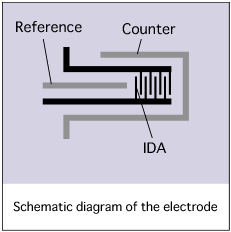
・HPLC measurement electrode
・Electrochemical measurement electrode
・Bio-sensor and chemical sensor electrode
・Chemically modified electrode
・Chemical reaction parameter monitoring electrode
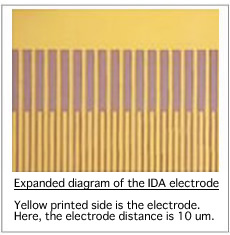
IDA Electrode is a pair of band electrode combined and meshes with each other as a generator electrode and collector electrode, therefore it is possible to make an electrochemical redox cycle upon the electrode as showed in figure.
By occurring the redox cycle on electrode increasing electrolysis current to raise measurement sensitivity. In experiment using common electrodes to analyze a small quantity of sample solution, the sample will consumed and exhausted due to electrolysis. However using this Interdigitated array electrode, the oxidation-reduction reaction occur repeatedly so the sample solution will not exhausted.
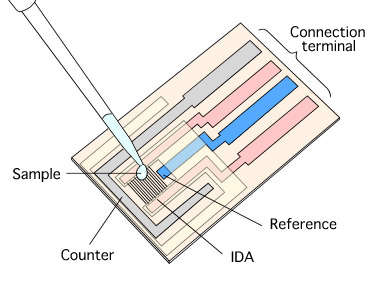
The voltammograms of ferrocene samples ((a),(c): 10 µL , (b),(d): 0.2 µL) using IDA electrode ((a),(b): Dual mode; (c),(d): Single Mode) are shown below. As they indicate, measuring mode makes obvious difference on their responses. Dual mode (a),(b) reinforce reduction current at collector electrodes with increase of oxidation current at generator electrodes, in addition, the current value is not affected by the sample volume, only depends on the concentration of the sample. At the measurement (d), comparing with (c), the current response is scarcely obtained, because the sample was consumed during the experiment, indicating that electrode response current of single mode is greatly dependent on the amount of sample solution.

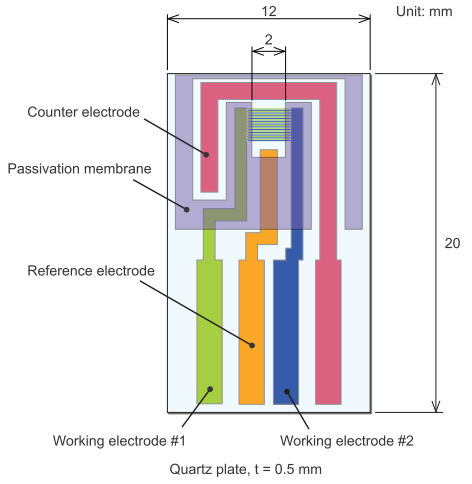 |
substrate dimension | |
| width | 12.0±0.1 mm | |
| length | 20.0±0.1 mm | |
| thickness | 0.5 mm | |
| electrode thickness | ||
| Au | 90 nm | |
| Pt | ||
| C | 1.2±0.1 μm | |
| ITO | 100 nm | |
| adhesive layer - passivation membrane thickness | ||
| Ti | approximately 10 nm (∗only for Au and Pt) |
|
| passivation membrane | about 1 μm | |
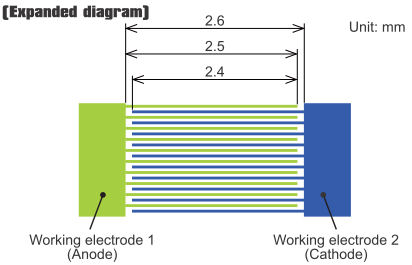
| Catalog No. | Description | Width (µm) | Interval (µm) | Length (mm) | Number of feet (pairs) | Film thickness |
| 012125 | IDA electrode (Au) | 10 | 5 | 2 | 65 | 90 nm∗ |
| 012126 | IDA electrode (Pt) | 10 | 5 | 2 | 65 | 90 nm∗ |
| 012127 | IDA electrode (Carbon) | 10 | 5 | 2 | 65 | 1.2 +/- 0.1 µm |
| 012128 | IDA electrode (ITO) | 10 | 5 | 2 | 65 | 100 +/- 20 nm |
| 012129 | IDA electrode (Au) | 3 | 3 | 2 | 65 | 90 nm∗ |
| 012130 | IDA electrode (Pt) | 3 | 3 | 2 | 65 | 90 nm∗ |
| 012257 | IDA electrode (Au) | 2 | 2 | 2 | 65 | 90 nm∗ |
| 012258 | IDA electrode (Pt) | 2 | 2 | 2 | 65 | 90 nm∗ |
| w/o passivation membrane | ||||||
| 012259 | IDA electrode (Au) without passivation membrane | 10 | 5 | 2.5 | 65 | 90 nm∗ |
| 012262 | IDA electrode (Pt) without passivation membrane | 10 | 5 | 2.5 | 65 | 90 nm∗ |
| 012266 | IDA electrode (Carbon) without passivation membrane | 10 | 5 | 2.5 | 65 | 1.2 +/- 0.1 µm |
| 012265 | IDA electrode (ITO) without passivation membrane | 10 | 5 | 2.5 | 65 | 100 +/- 20 nm |
| 012260 | IDA electrode (Au) without passivation membrane | 3 | 3 | 2.5 | 65 | 90 nm∗ |
| 012263 | IDA electrode (Pt) without passivation membrane | 3 | 3 | 2.5 | 65 | 90 nm∗ |
| 012261 | IDA electrode (Au) without passivation membrane | 2 | 2 | 2.5 | 65 | 90 nm∗ |
| 012264 | IDA electrode (Pt) without passivation membrane | 2 | 2 | 2.5 | 65 | 90 nm∗ |
| OPTION | ||||||
| 011066 | Cable kit for IDA electrode | |||||
| 011464 | Ag/AgCl Ink for reference electrode (2.0 mL) | |||||
∗ For Au and Pt, the thickness of the titanium adhesive layer is about 10 nm, resulting in a total thickness of 100 nm.
The IDA electrode is a very sensitive product. Here, some advice for the preservation and handling of IDA electrode will be described.
After receiving the product, it is recommended to test the insulation between the working electrodes using a tester.
If long-term storage, put the electrode in the case. Store the case in clean space such as desiccator, away from heat and moisture.
Any defects in the appearance (ex: pinhole on lead area, burr of glass) without any influence to the measurement, are not covered under warranty.